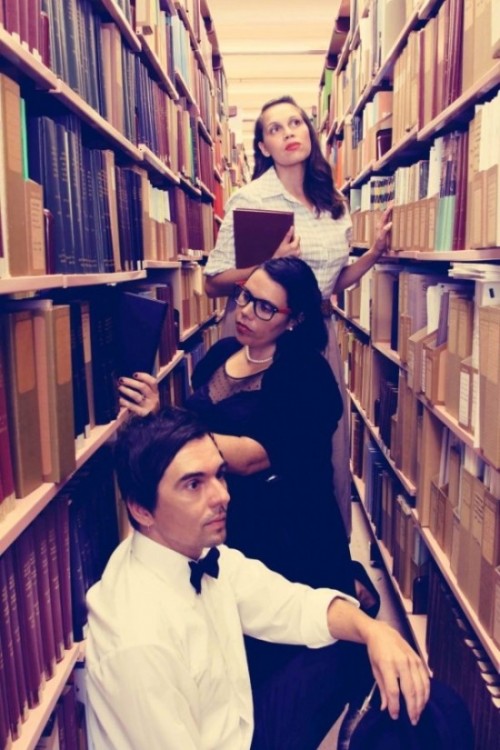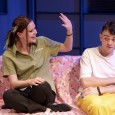It is a challenge to the non-Aboriginal Australian to consider that inanimate material objects can hold cultural memory. Even though we seem to spend the majority of our time chasing material possessions, we rarely, if ever, look beyond an object’s practical use or emotional gratification. Stuff is stuff – dead and lifeless – certainly not capable of retaining memories of the life around it.
A chance meeting with Aboriginal elder, Uncle Max Dulumunmun Harrison, has set musicians Kaleena Briggs and Nardi Simpson of the Stiff Gins and musician/producer Syd Green on a remarkable path of discovery. It is a path that will see them drawing out the ‘music’ remembered in Indigenous cultural objects.
Their Spirit of Things – Sound of Objects Project is exploring residual and embedded stories and songs retained in Aboriginal cultural material.
The three musicians – known as The Spirit of Things Collective – will listen to objects held in the Australian Museum in Sydney; listen as those objects reveal their stories. They explain that they will then “interpret those sounds into song and image and release them into the world where again they can breathe and speak”.
The project is conceived in four stages: Connect – where the collective will sit with objects in the Australian Museum and produce a wealth of material, creative and journalistic, inspired by these objects; New Breath – new songs inspired and released by the objects will be recorded in a studio; Speak – a series of performances incorporating objects, sound, image, movement, and storytelling; and Bestow – the creation of a new object that retains the memory, story and song created during this project.
The new object created through the Spirit of Things – Sound of Objects Project will reside at the National Film and Sound Archive in Canberra.
To me as a non-Indigenous Australian and a musician, I find it a beautiful idea. It is an idea full of the spirituality that I, and I’m sure many, many other musicians, yearn for in the act of making music.
I put some questions to Kaleena Briggs, Nardi Simpson and Syd Green regarding the Spirit of Things – Sound of Objects Project.
Q: What was the spark that began your journey with the Spirit of Things – Sounds of Objects project?
Kaleena: We (Stiff Gins) were fortunate to play at the Two Fires Festival in Braidwood, NSW a few years back. I remember we had the afternoon off and were about to get a coffee when we walked past the town hall theatre. Sitting on the steps was Uncle Max Dulumunmun Harrison, an Aboriginal elder from the Yuin people of the south coast. He was to give a talk at the theatre but no one had come. He said he was going to wait a while longer and then go. As we walked away, a wave of sadness fell over me and I started to cry. It saddened us that here was this very important person, an elder, a library of history, who was willing to impart freely that knowledge and his unique perspective of culture.
However, I believe it was meant to be, because Uncle was at the same cafe as us, with his family and we all got to chatting. And we realised it was meant to happen. Uncle discussed how stone and rock retained and were imprinted with the stories and sounds around it. This clicked with us as musicians, storytellers and as Indigenous people. That one afternoon, over coffees and good yarns, a seed of an idea was planted. And that idea over the last few years has now become a reality. We are grateful that our paths crossed with Uncle Max.
Q: What role has Uncle Max Duramunmun Harrison played in the project?
Nardi: Uncle Max is a very strong presence in the project. After meeting him at one of the first gigs Kaleena, Syd and I played together on his beautiful country, his words and outlook on culture and learning have imprinted strongly on us all. Looking back now, it’s as if his words were imbedded into our spirits and minds and led to the birth of the idea of Spirit of Things – Sound of Objects. Apart from his teachings on embedded story and sound and song, he is one of the most generous people we have ever met so not only are we inspired by his words, but his actions too.
We look forward to interviewing Uncle Max and capturing his ideas and thoughts so we can include them in the final performance of the project. But for now his words, and his gentle, generous and humorous spirit and support and encouragement of our music has led us on this incredible journey. His spirit flows within and through everything in Spirit of Things- Sound of Objects.
Q: How is the Australian Museum involved in the project? What other institutions are you looking at?
Nardi: The Australian Museum has allowed us access to its collections (which is available to all aboriginal community members) and supported us in three research days on site within the collections. The ultimate goal would be to have a touring exhibition of the objects and their accompanying performance in cultural institutions around the world, something we’d love to work with the museum on making happen next year. While informal in its nature, we feel our relationship with the museum is mutually beneficial. We get to access and interpret the collections stored there while the museum gets a first hand insight into a creative and cultural framework that animates their collections through a unique, Indigenous world view. We are both learning to navigate each other’s needs and expectations, which can be challenging but is ultimately very rewarding.
We are also really excited to be entering into a formal partnership with the National Film and Sound Archive in Canberra and with the help of their technicians and the Indigenous unit, will create our own ‘antiquated’ object with embedded story and song in the form of a wax cylinder of our recordings that we will then donate to the archive. This is a really exciting prospect, and we are so excited about how this part of the project will take shape. We feel very moved when we think we are going some way in recreating the steps taken 120 odd years ago by Fanny Cochrane Smith when she recorded the songs of her Tasmanian Palawa peoples onto wax cylinder.
Q: Do you feel it is possible for someone with a non-Aboriginal world view to understand the project and its aims?
Syd: Definitely. The culture of storytelling is more alive than ever. One of the special points about The Spirit of Things – Sound of Objects is that it seeks to release stories residing within cultural objects. In a way we’re acting as the voice for these stories but interpreting it as creative and musical beings. We’re really excited to share the journey. People are vibed with the project and curious and we’ve had such receptive and supportive responses from the community.
Q: What has the Spirit of Things – Sounds of Objects Project achieved so far and where does it go next?
Syd: The time at the museum has been about taking the time to listen with the objects and process these responses into musical ideas. We’re heading to a secluded farmhouse in the Southern Highlands of NSW to bunker down and write together. We’ll be taking everything we can carry to capture something unique to previous recordings we’ve made. It might resemble a sound track or soundscape that embraces rhythm and the magical harmonies of Kaleena and Nardi’s sweet voices. It’s going to be fun too creating from an artistic perspective. We also have some audio sketches from the Museum debriefs that will be a great starting point. It’s so exciting to be going into a recording session with the idea of creating an ambience as opposed to the standard verse-chorus type of songs.
Q: What is your ultimate goal for the project? Or is it an open-ended loop?
Kaleena: The importance of this project is to not rely heavily on any one aspect. I guess we all three have certain personal goals that we would like to achieve. But I believe I speak for all of us when I say that the process, the journey, is the reward. This project is important because it steps away from the recognised machine that we have followed before. Write songs+sing songs+record songs= a CD. We have played that mode before. And we are at a point in our lives and careers where we are searching for that passion again, that spark, and would love to create something that moves us.
For more information visit the Spirit of Things Collective website.




